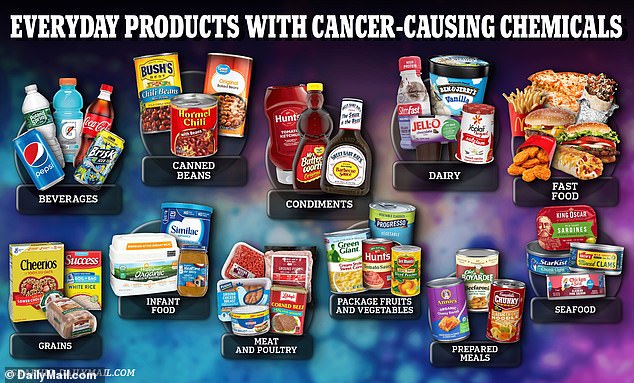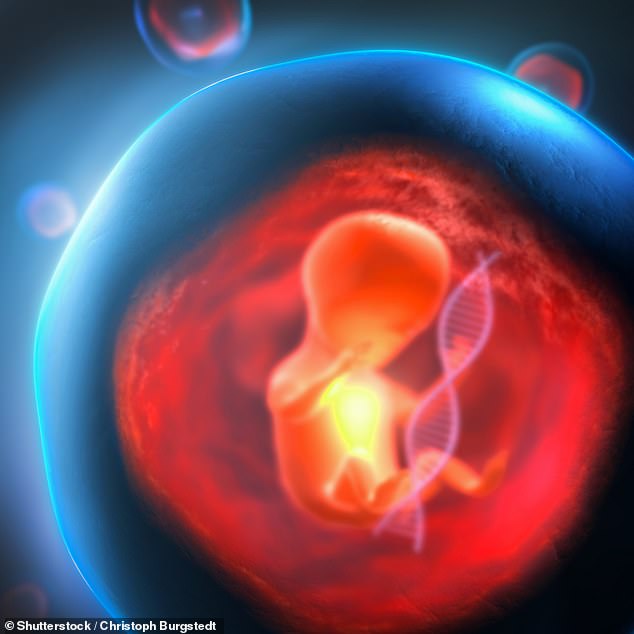Alarming research shows how cancer-causing ‘forever chemicals’ are passed from mothers to newborns
Scientists know that cancer-causing chemicals are transferred from mothers to newborns forever, but a new study has revealed how this happens during pregnancy.
Researchers from Fudan University in China analyzed blood samples from 1,076 participants and found 65 percent of polyfluoroalkyl substances (PFAS) present.
The team found that chemicals in the bloodstream enter the placenta, umbilical cord and breast milk forever, contaminating fetuses during and after pregnancy.
PFAS, microscopic substances that take thousands of years to break down, attach themselves converted into proteins in the body that transport them from the mother’s bloodstream (serum) via the placenta to the bloodstream of the fetus.
The researchers also noted that exposure to prenatal PFAS has been linked to higher susceptibility to infectious diseases, autism and attention deficit hyperactivity disorder (ADHD) in children.
Researchers from Fudan University in China discovered that polyfluoroalkyl substances (PFAS) can be transmitted to a baby through the placenta and breast milk
PFAS are found in most foods, air, water, soil and cleaning products, allowing them to penetrate human skin and enter the bloodstream.
The new study found that the amount of chemicals babies are exposed to depends on the mother’s diet, body mass index (BMI), the age they gave birth and their level of education.
During pregnancy, substances found in the mother’s bloodstream cross the placenta (which supplies oxygen and nutrients to the fetus) to reach the bloodstream of the temporary organ that connects a mother’s uterus to the umbilical cord.
The structure of the placenta acts as a barrier against negative substances such as viruses and certain drugs, but because PFAS are small molecules that can dissolve in fats, they can cross the placenta to reach the fetus.
These chemicals also tend to attach to proteins such as albumin, which facilitates the transfer of forever chemicals from the mother to the baby.
The PFAS affinity to bind itself during protein transport “could play a critical role” in transmission to the fetus, the study said.
The team found that some toxic chemicals move through the placenta more easily than during breastfeeding, but found that PFAS levels in 551 breast milk samples were above 50 percent.
Forever chemicals are found in body fat and can pass into breast milk, transferring them to the newborn along with healthy nutrients such as vitamins, minerals and proteins.
however, the Agency for Toxic Substances and Disease Registry reported that how the perennial chemicals get into breast milk is still not fully understood.
Although researchers found dangerous chemicals in breast milk and placenta forever, Linda Birnbaum, former head of the National Institute of Environmental Health Sciences and the National Toxicology Program, still advises that the benefits of breastfeeding outweigh the risk of possible exposure to PFAS. .
“I always emphasize to people that ‘breast is best’, even if there is contamination,” she said The hill.
The team also reported that umbilical cord serum contained more than 50 percent of five types of PFAS, taken from the placenta and the bloodstream of the uterus.

They are called ‘forever chemicals’ because they can linger in the environment for hundreds of years. They have been linked to cancers of the liver, kidneys, breasts, prostate and ovaries. Researchers found that the participants who consumed a diet high in animals and seafood had more PFAS in their systems
PFAS were called “forever chemicals” because they can linger in the environment for hundreds of years. They have been linked to liver, kidney, breast and ovarian cancer.
The researchers identified that the primary cause of PFAS in adult participants was their diet, with animal and seafood-based foods containing the highest levels of synthetic chemicals used to make stain and grease resistant products.
Forever chemicals build up in the body over a short period of time, but can take several months to decades to be eliminated from the body or metabolized.
“Given the accumulation and long half-life of PFAS, their levels in the third trimester of this study are higher than those in the second trimester, which mainly depends on the dietary and consumption patterns of the study population during pregnancy,” the study said. .

Chemicals build up in the body forever and can take several months to decades before they can be eliminated from the body or metabolized

PFAS are found in most foods, air, water, soil and cleaning products, but the amount of chemicals babies are exposed to depends on the mother’s diet, body mass index (BMI), the age they gave birth and their level of education.
Women with higher levels of education were associated with higher PFAS, which the researchers said was likely because they were able to purchase goods containing more dangerous chemicals, such as seafood.
PFAS are widespread and almost all Americans have these chemicals in their blood forever, according to the US Centers for Disease Control and Prevention.CDC).
There are some ways to reduce your exposure to PFAS, such as using treated or bottled water for drinking and cooking, avoiding fast food, microwave popcorn, and other takeout foods, and discontinuing use of products made with Teflon .
The researchers said they hope their findings will pave the way for companies to eliminate chemicals from food sources forever.
“Our findings are crucial for developing strategies to protect infants from the potentially harmful effects of PFAS exposure,” said study lead author Yaqi Xu.
‘Understanding the pathways and risks associated with these chemicals could lead to better regulatory policies and protective measures for the most sensitive among us.’
